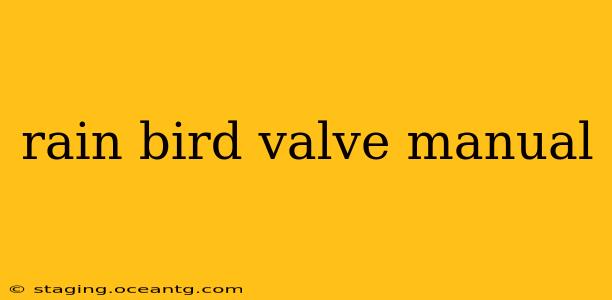Rain Bird irrigation valves are a cornerstone of efficient and effective landscape watering. Understanding your Rain Bird valve is crucial for maintaining a healthy lawn and garden while conserving water. This comprehensive guide covers everything from installation basics to advanced troubleshooting, ensuring you get the most from your Rain Bird system. We'll address common questions and provide practical advice to keep your system running smoothly for years to come.
What are the Different Types of Rain Bird Valves?
Rain Bird offers a wide range of valves designed for various applications and water pressures. Understanding the differences is key to selecting the right valve for your needs. Common types include:
- In-ground valves: These are the most common type, installed underground near your sprinkler heads. They come in various sizes and flow rates, depending on your system's requirements.
- Above-ground valves: Used in applications where underground installation isn't feasible, these valves are typically found in smaller or more accessible irrigation systems.
- Anti-siphon valves: Designed to prevent backflow, these valves are essential for protecting your water supply from contamination.
- Pressure-regulating valves: These valves maintain consistent water pressure throughout your irrigation system, ensuring even watering across your landscape.
How Do I Install a Rain Bird Valve?
Installing a Rain Bird valve correctly is crucial for its longevity and efficient operation. While specific instructions vary depending on the valve model, general steps include:
- Excavation: Dig a trench to accommodate the valve and its associated piping. Ensure proper depth and slope for efficient drainage.
- Pipe Connection: Connect the inlet and outlet pipes to the valve using appropriate fittings. Ensure all connections are secure and watertight.
- Backflow Preventer (if required): Install a backflow preventer according to local codes and regulations. This prevents contaminated water from entering your water supply.
- Valve Placement: Position the valve securely in the trench, ensuring proper alignment with the piping.
- Backfilling: Carefully backfill the trench, ensuring no damage to the valve or piping. Avoid compacting the soil too tightly around the valve.
Always consult the specific installation instructions provided with your Rain Bird valve model.
How Do I Troubleshoot a Rain Bird Valve?
Troubleshooting a malfunctioning Rain Bird valve involves systematically checking various components. Common issues and solutions include:
- Valve won't open: Check the power supply (if applicable), solenoid operation, and for any obstructions in the valve.
- Valve leaks: Inspect the valve body, seals, and connections for any damage or leaks. Replacement parts may be necessary.
- Low water pressure: Check for clogs in the pipes or sprinkler heads, and ensure proper water pressure at the source.
- Inconsistent watering: Check for obstructions in the sprinkler heads or uneven water distribution.
How Do I Maintain My Rain Bird Valves?
Regular maintenance significantly extends the lifespan of your Rain Bird valves and ensures optimal performance. This includes:
- Flush the system regularly: This removes sediment and debris that can clog the valve and reduce efficiency.
- Inspect for leaks: Regularly check for leaks around the valve body and connections.
- Lubricate moving parts: Lubricate the valve stem and other moving parts as recommended in the manufacturer's instructions.
- Check for damage: Inspect the valve for any physical damage that could compromise its function.
What is the Warranty on a Rain Bird Valve?
Warranty information varies depending on the specific model and purchase date. Refer to your valve's documentation or contact Rain Bird directly for details on the warranty coverage.
How Often Should I Replace My Rain Bird Valves?
The lifespan of a Rain Bird valve depends on several factors, including usage, water quality, and maintenance. With proper maintenance, valves can last for many years. However, signs of significant wear and tear, frequent malfunctions, or leaks may indicate the need for replacement.
This comprehensive guide provides essential information about Rain Bird valves. Always refer to the specific manual for your valve model for detailed instructions and troubleshooting guidance. Proper installation, maintenance, and timely troubleshooting will ensure your Rain Bird irrigation system provides years of reliable and efficient performance.
